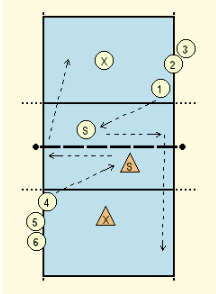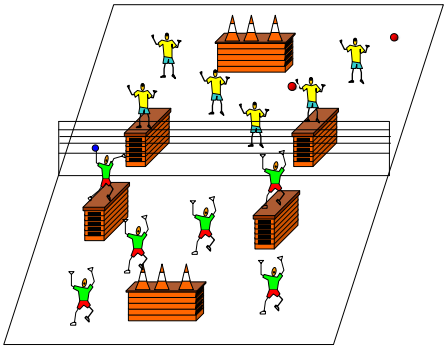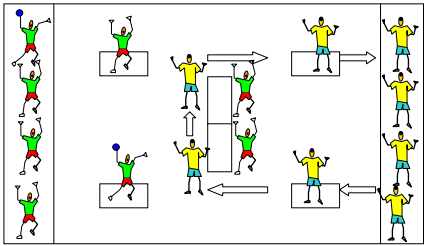Volleyball drills

- The purpose of the exercise is twofold:
- the defender must learn to "read" where the attacker is going to hit
- and the attacker has to see where the defence stands before hitting.
- We work with two regular playmakers, on both sides of the field a row of attackers on the left-for position.
- And two defenders, who may choose where they position themselves on the field.
- A defender has to defend the attack 10 times, preferably a nice pass, but touching is enough.
- If the attacker hits the net or leaves the field, that also counts.
- And the attackers may only smash, no prick balls!
- After the attack, the attacker retrieves the ball and joins the other line.
- When the defender has defended a ball 7 times, he changes with an attacker.
- If there are less players, the exercise can also be done, but then on one side.
- The attacker retrieves the ball and then joins the same line.
- The blocking player joins in and indicates where he is going to block and the mid-back goes to his place.
- In the field there is a team formation.
- After each service rally finish and turn around a spot, so everyone knows his place.
- After that a game of 6 against 4.
Line walk around the field.
Players stand divided on the long side line of the field and start with a quiet run around the field. After 3 laps of quiet running in, they each get an assignment. They carry out the assignment on the short sides of the field and walk on the long sideline at a steady pace.
- connecting pass, sideways
- cross pass
- knee lift
- Heels - buttocks
- Turn right arm forward
- Left arm forward
- right arm backwards
- backward left arm
- sideways shuffle
- attack passes and smash move
Ankles, knees, hips, shoulders, neck, wrists loosen up
Abdominal exercises: 1 minute per part
- Sit-ups, quickly up, hold for a moment and then slowly back down
- right elbow up to left knee and vice versa at a very slow pace
- with ball from left to right
- with ball from feet to head
- planking on hands, ball under you from left to right
- mountainclimbers
- hip cross over
- scorpion
Throwing in on 2 fields with 4-5 players per field.
Symmetrical throw with both hands, throw into the hands of the player and stand still before throwing.
- Throw from the neck high ball
- throw from the neck tight ball
- throw with punch from chest high ball
- throw with a punch from the chest tight ball
- throw with right
- throw with left
- throw with bounce
- Overhead play
- Underhand
- One side overhand, other side underhand
- Free play to each other
- In today's top basketball we can see that the two-handed pass from above the head is frequently used.
- It is therefore important that we stimulate the players to use this pass in certain situations.
- Jumping up on the couch,
- then jump off high,
- down on his knees and
- then jump up high again
- The 2 throwers stand on the boxes and the attackers walk on the ground.
- The throwers and attackers try to knock over the pylons or throw off attackers at the opposing team.
Rules:
- You are not allowed to defend your pylons, you can use chalk to make a circle in which the pupils are not allowed to stand.
- As a thrower and as a declarer you can choose to aim at the declarer or at the pylons.
- The defender is not allowed to fend off but if he catches the ball the thrower is out and a new thrower has to come in
- When a player is thrown out, he/she has to sit on the waiting bench, when a pylon of the opposing team is knocked down, all the keepers can go in again.
- Throwers cannot be thrown off.
- When the opponent's pylons have been knocked down, you have won the game, or when all of the opponents' helpers have been removed.

- Divide the group into two teams.
- From both teams 2 children stand on the mats belonging to their team.
- Also 2 children per team stand in front of the cupboard, these are the goalkeepers.
- The children who stay over, go to the throwing square (see drawing).
- When the balls come into play, the children in the box are supposed to throw the balls against the cupboard.

- In pairs with 1 ball and with the net in between.
- On a 3 meter line and serve calmly to each other.
- Throwing up and concentration.
- Same but increase the distance.
- If it goes well then increase the distance again.
- When both players are behind the backline, serve 5 times good.
After that butterfly:
service, reserve, pass, catch
Making an attack run:
- Right handed: left, right, left
- Left handed: right, left, right
- jump with your arms
- Hit with your belly
Pass
- Line up attackers on the outside, pay attention to the run-up and the arms.
- Row of attackers on middle and back
- 3 attackers on position 2, 3, 4 and reserve.
- SV comes in from the back
- in the opposite field 3 blockers on position 2, 3, 4
- at position 6 is a defender
- Trainer throws ball to defender
- defender passes to SV at position 2-3
- SV gives set up at position 2, 3 or 4
- Blockers block and block defence
- attacker gets ball, reserve attacks
- defender changes after 10 good balls
- The players stand in 2 or 3 groups, each with an equal number of players.
- They stand in a row behind each other. The player in front has the ball.
- He passes the ball through his legs and the other players do the same until the ball reaches the last player.
- This last player runs forward with the ball and so the exercise begins again until the whole row is over the line.
Play fanatically in threes. After you play the ball, walk to the other side and connect. Player A plays to player B and connects with player B at the back. Player B plays to player C and connects with player C at the back. Etc.
Next:
- 1 with ball at the net,
- 1 without ball on the backline, flat on belly.
- Attacker hits ball, defender defends on 7meter line,
- Then short ball on 3meter line.
- Dumbbell torso rotation is good exercise for improving core rotational speed.
- First of all, you need to prepare a dumbbell. Initially, you need to hold a dumbbell in the right hand.
- After that, you should touch the ground in front of the left foot. Now, it's time for you to explode from low to high.
- Finally, you'll have the dumbbell above the head on the right side.







